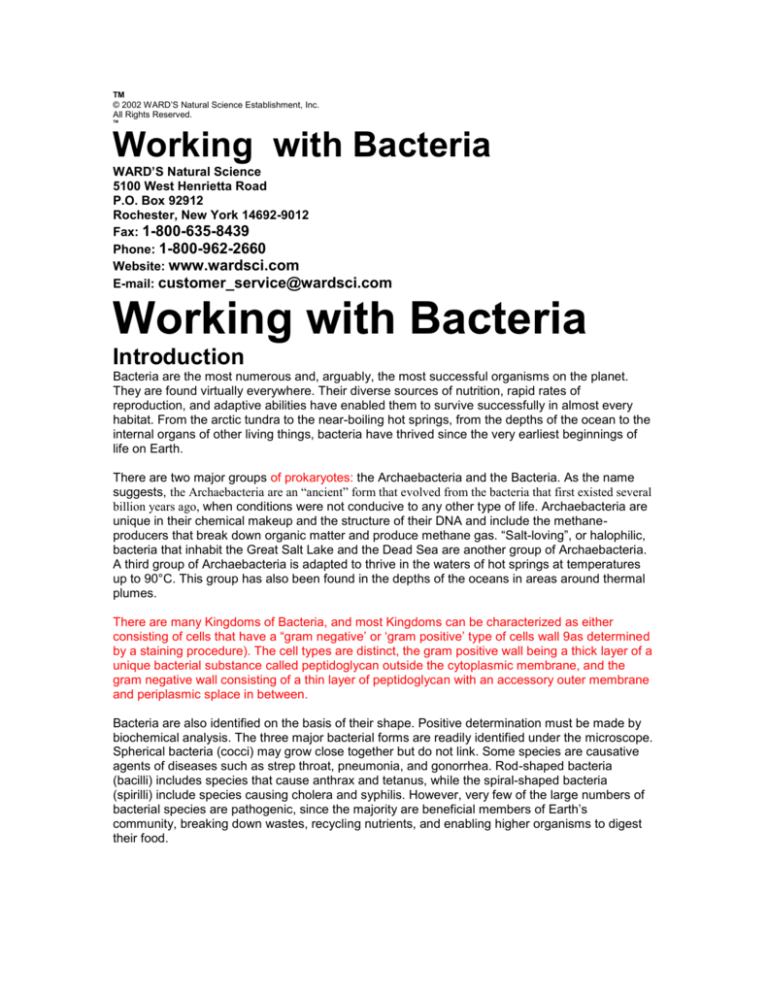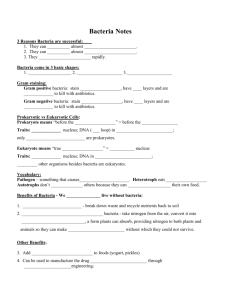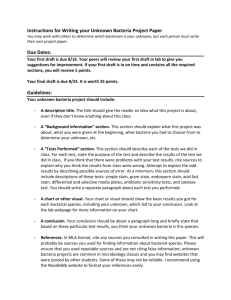
TM
© 2002 WARD’S Natural Science Establishment, Inc.
All Rights Reserved.
TM
Working with Bacteria
WARD’S Natural Science
5100 West Henrietta Road
P.O. Box 92912
Rochester, New York 14692-9012
Fax: 1-800-635-8439
Phone: 1-800-962-2660
Website: www.wardsci.com
E-mail: customer_service@wardsci.com
Working with Bacteria
Introduction
Bacteria are the most numerous and, arguably, the most successful organisms on the planet.
They are found virtually everywhere. Their diverse sources of nutrition, rapid rates of
reproduction, and adaptive abilities have enabled them to survive successfully in almost every
habitat. From the arctic tundra to the near-boiling hot springs, from the depths of the ocean to the
internal organs of other living things, bacteria have thrived since the very earliest beginnings of
life on Earth.
There are two major groups of prokaryotes: the Archaebacteria and the Bacteria. As the name
suggests, the Archaebacteria are an “ancient” form that evolved from the bacteria that first existed several
billion years ago, when conditions were not conducive to any other type of life. Archaebacteria are
unique in their chemical makeup and the structure of their DNA and include the methaneproducers that break down organic matter and produce methane gas. “Salt-loving”, or halophilic,
bacteria that inhabit the Great Salt Lake and the Dead Sea are another group of Archaebacteria.
A third group of Archaebacteria is adapted to thrive in the waters of hot springs at temperatures
up to 90°C. This group has also been found in the depths of the oceans in areas around thermal
plumes.
There are many Kingdoms of Bacteria, and most Kingdoms can be characterized as either
consisting of cells that have a “gram negative’ or ‘gram positive’ type of cells wall 9as determined
by a staining procedure). The cell types are distinct, the gram positive wall being a thick layer of a
unique bacterial substance called peptidoglycan outside the cytoplasmic membrane, and the
gram negative wall consisting of a thin layer of peptidoglycan with an accessory outer membrane
and periplasmic splace in between.
Bacteria are also identified on the basis of their shape. Positive determination must be made by
biochemical analysis. The three major bacterial forms are readily identified under the microscope.
Spherical bacteria (cocci) may grow close together but do not link. Some species are causative
agents of diseases such as strep throat, pneumonia, and gonorrhea. Rod-shaped bacteria
(bacilli) includes species that cause anthrax and tetanus, while the spiral-shaped bacteria
(spirilli) include species causing cholera and syphilis. However, very few of the large numbers of
bacterial species are pathogenic, since the majority are beneficial members of Earth’s
community, breaking down wastes, recycling nutrients, and enabling higher organisms to digest
their food.
General Technique
Caution: Do not work with pathogenic (disease-causing) organisms unless you have had
sufficient training and experience intheir handling. Treat all bacteria as being pathogenic, both to
establish proper work habits and because of the chance (however small) of a culture are
inadvertently becoming contaminated by a pathogen. Even non-pathogens supplied by WARD’S
arepure cultures and are heavily concentrated, and, as such, should be handled with care.
1. Sterilization
a. Media and glassware: Use an autoclave or pressure cooker at 15 lbs. for 15 min. at
100°C.
b. Glassware: Dry heat in oven at 160°C for at least two hours.
2. Wear a clean lab coat, smock, or apron to protect clothing and to reduce possible
contamination of cultures.
3. While in the lab, avoid any hand to mouth operations, such as eating, smoking, or licking
adhesive labels.
4. Wash hands thoroughly with soap and water, both before and after working with cultures.
5. Keep work surface clear of any unnecessary objects (e.g., books, purses, etc.)
6. Wash work surface with a capable disinfectant, such as 10% Lysol, 70% alcohol, or household
bleach both before and after working with cultures.
7. Culture transfers
The only articles of equipment needed to make a transfer from the initial culture to a tube of
sterile medium are a Bunsen burner or similar heat source, and an inoculating loop, needle, or
sterile swab.
a. Hold both tubes in the left hand (Fig. 1).
b. With the needle in the right hand, pass the entire length
of the wire through the flame until it has all been red hot
(Fig. 2).
c. While still holding the needle, QUICKLY remove the caps or plugs from the tubes,
holding them between the fingers of the right hand (Fig. 3). Flame the mouths by passing
them two or three times through the burner flames (Fig. 4). Hold these tubes almost
parallel to the table top if they contain a broth. This will reduce the possibility of air-borne
contaminants.
d. Touch the needle to the medium in the culture tube to be sure it is cooled, and then to
the culture mass. Apply the needle to the sterile medium in the other tube (Fig. 5). (This
may be done either by streaking the surface of a slant, making a stab into a semi-solid
media, or swirling the needle in a broth.) If Petri plates are used, place them on the table
and lift the cover only enough to maneuver the needle when inoculating. It should be
noted that it is not necessary to attempt to remove a large volume of the culture mass
with the needle. A slight touch will place more than enough on the needle to make the
inoculation.
e. Flame the mouths of the tubes and cap them.
f. Flame the inoculating needle until it is “red hot”.
8. If screw cap culture tubes are used, the cap should be kept loose to allow the aerobic cultures
to get oxygen. (Most common bacteria and molds fall into this category.)
9. If cultures are to be kept for an extended period, however, they should be sealed tightly to
prevent dehydration of the media. Then refrigerate to slow the metabolic processes of the
organisms, unless the label states no refrigeration.
Procedures to follow in a biological spill:
Materials on hand at all times:
Bio-hazard bag (autoclavable)
Paper towels
Gloves
Tongs or similar instrument
Disinfectant solution — 70% isopropyl alcohol, 10% Lysol, or household bleach in a squeeze
bottle.
Procedure:
1. Pour disinfectant on all broken glass and contaminated surfaces. Extend coverage over 3”
around original (contaminated) area.
2. Cover the spill area with paper towels. Add additional disinfectant to fully saturate them. Wait
30 minutes.
3. Wearing rubber gloves and using tongs, pick up all glass or residue along with paper towels
and place in Bio-hazard bag.
4. Disinfect the area again by following steps 1–3.
5. Seal the Bio-hazard bag and autoclave the contents. Dispose.
6. Wash hands thoroughly.
Discarding of Microbiological Cultures
All cultures must be autoclaved prior to disposal.
1. Autoclave at 121°C, 15 psi for 15 minutes.
2. Contents of containers may be discarded.
Note: Do not dump melted agar down the drain as it will later solidify and block flow.
3. Wash glassware in hot water and rinse well.
If an autoclave is unavailable, soak in bleach or incinerate.
Care of Cultures
When you receive your live cultures, they should be refrigerated to slow metabolic rates (note,
many bacteria survive well at room temperature for long periods of time). The recommended
medium and the optimum temperature for each bacterium is given on the tubes of the cultures
supplied by WARD’S. The above technique is used for all but the following organisms:
1. Photobacterium fischeri
a. P. fischeri, a marine bacterium, is one of the simplest light producing organisms and
also one of the easiest to work with.
b. Since P. fischeri will only produce light in fresh cultures, it is necessary to subculture it
in order to observe its luminescent characteristics. This should be done 18–48 hours
before the luminescence is to be observed.
c. For best results, the room in which the observations are to occur should be completely
darkened, and the eyes of the people who observe the experiments should be allowed to
acclimate to the darkness. If this is not feasible, the room should be made as dark as
possible and the experiments may be viewed in the bottom of a double paper bag with
the opening of the bag held tightly about the viewer’s eyes.
2. Halobacterium salinarum requires a 25% salt medium for growth. It is a slow growing
organism, taking 7–10 days at 37°C for agar slants. Twelve drops of Halobacterium solution (in
25% salt water) added to the tube and incubated horizontally in a slant rack will provide ample
bacteria. Halobacterium can be stored at room temperature and can survive at temperatures up
to 40°C.
3. Chromobacterium violaceum (pathogen) should not be refrigerated or subjected to cold
temperatures as the culture will quickly die. Chromobacterium prefers to stay at 30°C and will
keep for months this way.
4. Aquaspirillum prefers room temperature storage, although refrigeration will not hurt the culture.
Spirillum volutans prefers to be held at 30°C. Rhodospirillum rubrum is photosynthetic and needs
room temperature and a light source.
Lyophilized (freeze-dried) Bacteria Cultures
Under this mode of culture preservation, bacteria cultures will remain true-to-type for at least two
years. It is recommended that these cultures be stored at 5–6°C, which is normal refrigeration
temperature. Culture re-establishment requires no sophisticated equipment or special technical
experience. A serological pipet, along with general sterile technique, is all that is required. Please
follow the instructions on the enclosed cards and be assured of success.
1. Using a sterile serological pipet, aseptically add to the lyophilized material no more than 0.5 ml
of the appropriate sterile liquid transfer medium.
2. Mix well by drawing the hydrated cell suspension up and down through the pipet at least ten
times.
3. Using a sterile swab, inoculate the agar.
4. Put remaining culture in broth tube. Re-established culture may then be sub-cultured onto
growth medium.
5. All materials used (shell vial, pipet, etc.) should be autoclaved prior to disposal.
6. Incubate agar tubes horizontally and agar plates agar side up.
Given proper treatment and conditions, freeze-dried cultures will grow out in 24 – 48 hours. Some
strains may exhibit a prolonged lag phase and should be given twice the normal incubation period
before discarding as unviable.
Observing Bacteria under the Microscope
1. Spread a thin film from the culture on one half of a microscope slide, using the inoculating loop
or needle.
2. Let the film dry.
3. Flame-fix the film by passing the smeared end of the slide through a Bunsen flame several
times.
4. Flood the slide with 1% Methylene Blue stain (several drops will do).
5. Let stand for several minutes, then dip the slide into a container of water to remove the excess
stain.
6. Blot dry. Do not rub, as this may remove the prepared culture from the slide. Add a drop of
immersion oil and examine under high power (100X).
This procedure gives a quick look at bacteria and will easily demonstrate bacteria shape.
Gram Staining Procedure
1. Flame-fix a bacterial smear as described above.
2. Add several drops of Gram’s Crystal Violet stain.
3. Let stand for one minute, then rinse by dipping in water.
4. Add several drops of Gram’s Iodine Solution to “set” the stain.
5. Let stand one minute, then rinse by dipping in water.
6. Tilt the slide, then add 95% alcohol as a destain. Add drop by drop, letting the alcohol flow over
the stained smear. Do this until there is no more color in the runoff. This step is to remove the
color from gram-negative bacteria.
The gram-positive organisms will retain the purple color.
7. Counterstain with Gram’s Safranin stain. Allow to stand for about 15 seconds, then rinse as
before. Blot away excess moisture and allow to dry.
8. Add a drop of immersion oil and examine under high power (100x).
The cell walls of gram-negative bacteria are chemically different. They have a higher lipid content,
which allows the alcohol destain to wash the stain out of the cell. The most accurate
determinations using the Gram technique are done with newer cultures, preferably less than 24
hours old, although to view spores in Bacillus sp. or Clortridium sp. Older cultures are necessary.
© 2002 WARD’S Natural Science Establishment, Inc.
All Rights Reserved.
TM
WARD’S Natural Science
5100 West Henrietta Road
P.O. Box 92912
Rochester, New York 14692-9012
Fax: 1-800-635-8439
Phone: 1-800-962-2660
Website: www.wardsci.com
E-mail: customer_service@wardsci.com









